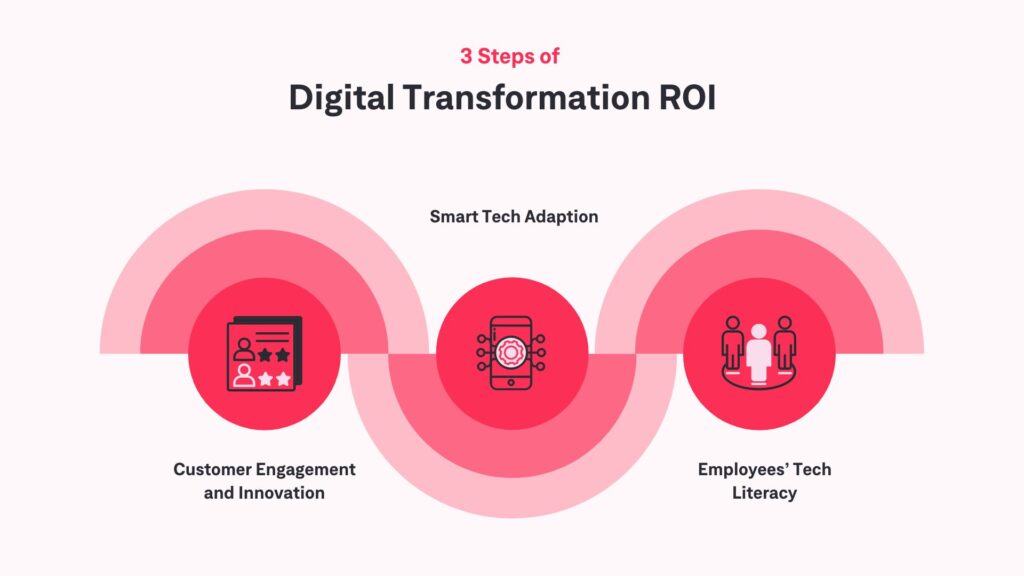Digital transformation has become the buzzword du jour for businesses large and small. Any business leader – and perhaps their aunts as well – is digitizing in 2024. Swimming in the sea of jargon and superficial reasons behind digitization is therefore expected.
The WHYs echoed throughout offices are often as common as a coffee machine. “Our competitors are doing it,” they say, or worse, “Everyone’s doing it.”, “AI is the future,”, “We need to be faster and more efficient”… the rumble goes on and on. Amidst this noise, we can’t help but wonder if the true reason behind – if you don’t mind – digital transformation is lost. Are companies just changing for the sake of change?

In the grand scheme of things, the true purpose behind digital transformation indeed gets lost in translation. While 89% of large companies worldwide are digitizing, striking data pinches the nose: they’ve only captured 31% of the expected revenue lift and 25% of the anticipated cost savings from these efforts. This means that only one in three to four companies get to see the silver lining. That’s not much – especially considering the costs, the level of expertise needed, and the cultural backlash associated with digitization. Plus, stakeholders and eventual partners know the uncertainty associated with the digital shift – can you imagine their reaction to it as well?
Again, are we digitizing for the sake of well, digitization, or is there a tangible ROI waiting at the finish line? It’s a question that demands thoughtful consideration in an era where businesses can’t afford to merely jump on the bandwagon. We hope this piece helps you steer it purposefully forward.
Hard Evidence for Digital Transformation ROI
We wanted to find out if using digitization and AI helps businesses do better. So, we looked at the study of 80 big banks from 2018 to 2022. By examining different metrics, researchers wanted to find patterns that set companies either for triumph or a bellyflop.
Guess what? The banks that used the tech well with clearly defined goals saw a lot bigger success in the end. Between 2018 and 2022, 20% of the best banks gave back 8.1% profit to their owners every year, while the others only gave 4.9%. The tech-savvy banks also got better at making more profit with the money they had, growing from 15.5% to 19.3%. The others didn’t improve as much, going from 13.6% to 15.3%.
Moreover, to move beyond just banks, Deloitte’s analysis indicates that employing the correct digital transformation strategies increases market capitalization by up to $1.25 trillion for all Fortune 500 companies. Conversely, inappropriate combinations pose a risk, potentially eroding market value and putting over $1.5 trillion at stake.
The key takeaway? Successful digital transformation requires more than ambition and bold investments; it demands strategic precision.
5 Common Missteps That Turn ROI into a Fantasy

Lack of Clear Strategy: Imagine building a house without a plan – probably a failure. That’s what happens when a company doesn’t have a clear strategy for its digital transformation. Trying to find a way in the dark without a flashlight and a map is proven to be symptomatic of a failing company. And it’s funny, right? Who in their right mind would stroll through the woods aimless? Well, the majority it seems… In fact, Deloitte confirms that the link between the strategy and action taken is the number #1 determining factor in deriving the most value from digital transformation.
Resistance to Change: You love your favorite cozy blanket, and suddenly someone tries to take it away. That’s how employees might feel when faced with digital changes. If a company doesn’t address this and make everyone supportive of the new reality, it’s like having a grumpy friend who doesn’t want to play a fun game.
Insufficient Talent and Skills Development: Think of a soccer team with players who never practiced together. Despite the obvious talent, they might struggle during a game. Similarly, if a company doesn’t train its team or hire skilled strategic partners, the digital game can become really tough and results may fall just outside of the reach.
Sticking to Legacy Systems to Cut Costs: Imagine having a smart home system and still using the Nokia 3310. Changes and updates are great, but companies need to be smart about what they can keep and what they need to be merciless with. This is where technical expertise is required to properly assess the existing situation and move forward.
Overlooking Customer Experience: Think of a restaurant that forgets to put your favorite dish on the menu. If a company doesn’t focus on what customers want, it’s like cooking a meal nobody is excited about. For digital changes to succeed, companies need to listen to their customers and do so throughout all the channels – it’s like adding the secret ingredient to make everyone happy.
In the end, a successful digital transformation is like putting together a giant puzzle. Each piece (strategy, embracing change, skills, good data, and happy customers) is crucial to creating the whole picture of success!
3 Critical Steps to Witness Digital Transformation ROI

#1 Focus on Customer Engagement and Innovation
Companies aiming to stand out from their competitors in digital ROI are prioritizing customer engagement and innovation over operational efficiency, according to a recent survey by McKinsey. The survey also reveals a growing trend where tech is seen as a key factor in creating strategic distance from competitors, with over one-third of respondents emphasizing its role. Notably, top-performing companies show more ambitious goals, investing twice as much in building new digital businesses compared to their peers. This highlights that shifting focus towards customer-centric strategies and innovation – something Net Group’s CEO is a leading advocate of – is more lucrative in the end.
#2 Smart Tech Adoption is Critical
For companies aiming to “nail the digitization”, having essential tech capabilities is crucial. Successful companies, as per the survey, invest more in employing the right tech to meet KPIs. They are notably more aggressive in adopting automated processes for testing and deploying new tech, along with embracing agile and DevOps practices for faster innovation and cost-effective execution. Additionally, top performers lead in the adoption of the public cloud, enhancing their agility and efficiency while maximizing the value of digital investments.
It’s worth noting that the survey underscores the importance of smart tech adoption rather than necessarily custom solutions. The emphasis is on selecting software, whether off-the-shelf or custom, that effectively addresses critical needs. Expert assessment is key in ensuring the chosen solution meets the company’s requirements, aligning with the broader strategy for customer engagement and innovation.
#3 Focus on Employees’ Tech Literacy
Finding the right tech talent, both at the frontline and executive levels, remains a persistent challenge to enhance digital performance. The survey suggests that attracting and reskilling tech-savvy executives is even more challenging than securing frontline technical talent. Integration of both groups into the organization poses a similar level of importance.
Notably, top economic performers excel in managing executive tech talent. Furthermore, they are more likely to have a tech-savvy C-suite. This underscores the critical role of tech-savvy management in navigating digital change. Moreover, the best-performing companies excel at welcoming and keeping new hires in tech roles. This is crucial due to the growing scarcity of tech talent. Successful companies often balance having in-house tech experts and collaborating with external partners for the best results. Additionally, they stand out by integrating new digital hires directly into the business, rather than confining them to the IT department.
Similar insights

Smart Workflows: AI Tools and Tips for Busy Leaders
16/12/2025
Supply Chain Attacks: Rethinking Third-Party Trust
10/12/2025
Choosing the Right Tech Stack in Uncertain Times
25/11/2025
How to Pitch and Get Your Ideas Approved at Work
12/11/2025
12 AI Cyberattacks That Made CEOs Very Cautious
21/10/2025
14 Books Smart Tech Leaders Are Reading This Fall
07/10/2025
Protect Your Crown Jewels: The Heart of Your Cybersecurity
15/09/2025
How Renown Business Executives are Using AI?
12/08/2025
Think You’re Secure? PEN Testing Will Tell You
15/05/2025
Let the success
journey begin
Our goal is to help take your organization to new heights of success through innovative digital solutions. Let us work together to turn your dreams into reality.